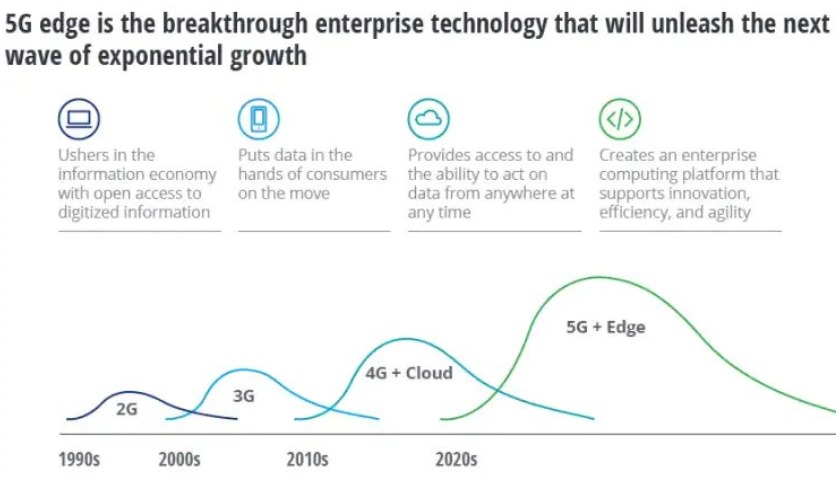Businesses have to deal with enormous amounts of data on a regular basis. It allows them to gain valuable insights that allow them to improve performance and realize goals. However, this data is of no use if it cannot be processed quickly and accurately. Furthermore, not all applications and data can be easily migrated to and operated on cloud networks. By combining edge computing and 5G technology, enterprise IT leaders can overcome this challenge.
90% of industrial enterprises will utilize the 5G edge ecosystem by 2022. 5G rollouts, in particular, have already started to gain momentum in the past two years in the North America and Asia-Pacific region. Many businesses are investing in 5G networks to make their business networks more cost-efficient. When they combine the speed of 5G with edge computing’s low latency processing capabilities, businesses can realize an agile, efficient, and IoT-driven future. Here’s how.
How are edge computing and 5G interlinked?
Intuitive operators can combine commercialized edge computing with 4G to provide “good enough” groundwork for 5G. This can overcome limitations in 5G geographic or device coverage. Even though edge computing clubbed with 4G will not be as high performance or cost-efficient as 5G, it will provide the basis for securing a greater demand for 5G edge services. Here’s why:
- Edge computing architecture keeps data close to the source, while 5G technology gets it to its destination as quickly as possible.
- Edge messaging systems coupled with 5G increase an application’s connectivity and enable near-instant communication.
- Deployed together, edge computing and 5G-enabled devices can help enterprises achieve faster speed, lower latency, and higher data throughput.

The current state of edge computing and 5G rollouts
Last year, the global pandemic slowed down the deployment status of 5G. Today, major operators, software and hardware providers as well as platform groups around the world are pursuing 5G with zeal.
Shamik Mishra, CTO of Capgemini Engineering recently stated that “all major telecommunication companies in the U.S. and Canada are aggressively pursuing 5G rollouts and have developed comprehensive B2B offerings for enterprises.” Earlier this year, Verizon Business and AWS announced that they will start delivering private mobile edge computing (MEC) to enterprises in the US. This will result from an integration of Verizon’s private 5G network with AWS Outposts. This mobile or multi-access edge computing (MEC) offering will provide unified connectivity and fully managed storage.
EY estimates that 69% of enterprises will adopt 5G by 2025. This shift will pose new opportunities, challenges, and competitive threats for the telecom industry. Netscribes’ 5G for enterprise applications report uncovers the critical aspects of the emerging 5G enterprise ecosystem and highlights the emerging opportunities for different stakeholders. Read the in-depth analysis here.
Today, there are only nascent markets for the types of applications 5G enables: AR, mass IoT, robotics, AUVs/drones, et al. Edge computing can provide developers an environment to create 5G applications that do not exist today. What makes edge computing and 5G so powerful is that together, they can be applied to an almost infinite range of devices – from the smallest sensor to an entire vehicle, ship, building, or city. This will have defining implications for enterprises globally.
The impact of edge computing and 5G on enterprises moving forward
1. Condition-based monitoring in manufacturing and logistics with computer vision
Computer vision systems can play an important role in disruptive digital technologies. In addition to real-time analysis and decision-making, it allows enterprises across industries to control and automate certain functions. As cameras become more ubiquitous and connected, supply chain operators will be able to use AI to keep track of stock and optimize processes. Organizations can validate safety protocols and compliance by using computer vision technology on factory floors and in offices.
Key takeaway: Edge computing and 5G can significantly enhance the potential of computer vision and AI technologies. From image recognition and facial authentication to event detection (fire, smoke, etc. ), 5G edge can deliver immediate value to users. For example, smart, connected equipment can automatically adjust calibration settings in manufacturing facilities, increasing yield and reducing defects. Additionally, 5G-enabled AR/VR applications can guide operators through maintenance, repair, and inspection processes.
2. Creating more responsive, dynamic networks to empower IoT strategies
For large amounts of data to be processed and transmitted quickly, innovative IoT solutions need increased connectivity at the network edge. Edge computing and 5G have given advanced driver assistance systems (ADAS) a new position in autonomous vehicles. For instance, Mercedes uses edge servers and 5G wireless communication to reduce latency and increase bandwidth for sensors with real-time authentication to ensure their cars don’t get hacked. In the healthcare space, IoT-enabled Medtech devices with 5G edge capabilities can help analyze patient health data quickly and accurately while maintaining patient privacy.
Key takeaway: New data-driven 5G applications will lead to innovative business models in the near future. With edge computing and 5G, enterprises can completely transform how they design and deliver network services. Rather than designing their infrastructure from the inside out, the focus will shift to the edge where the end-users or customers are located. With 65% of businesses keen to implement 5G edge technology within two years of availability, they can overcome the longstanding last-mile latency problems associated with existing network infrastructure.
3. Enhance enterprise security with perimeter scanning, threat detection, and patching
56% of technology executives rate security as the biggest challenge in adopting advanced 5G wireless technologies. Due to the growth of IoT endpoints, corporate security is at a greater risk today. Thus, while 5G can support a greater density of devices in a given area, when combined with mobile edge computing, enterprises can process large volumes of data in a secure environment and ensure virtual collaboration easily.
Key takeaway: To transfer and receive data in a secure environment with the help of 5G edge technologies, enterprises need to implement best practices that include end-node protection, better end-to-end encryption, and multi-factor authentication for every edge device. Furthermore, by deploying application-layer firewalls, administrators can easily block suspicious traffic.
In conclusion
By the end of this year, the earliest adopters of edge computing and 5G technology will be smart homes, smart cities, manufacturing, fleet management, logistics, entertainment, and content distribution networks. Energy, utilities, transportation, automotive, and fintech sectors will follow between 2022 and 2024.
For most business leaders, 5G edge is crucial to digital transformation. In addition to the quality of service, the system provides enhanced security, low latency, and massive machine-type communication. Whatever the industry, enterprises of the future will be intelligent. Is your company future-ready? With Netscribes’ technology intelligence solutions, you can stay prepared for the next wave of technology requirements, solutions, and the business landscape ahead of the competition. To learn more, get in touch with us today.






